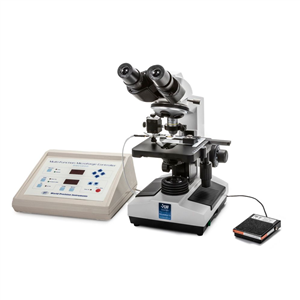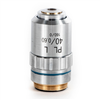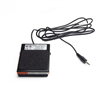

DMF1000-2
Microforge & W30S Stereo Microscope 220V
- Overview
- Specifications
- Accessories
- Citations
- Related Products
Overview

There are 1 images available to view - click to enlarge and scroll through the product gallery.
DMF1000 Datasheet
/ Download as PDF
DMF1000 Instruction Manual
/ Download as PDF
- Microprocessor-controlled microforge
- Digital signal processor technology precisely controls the polish heating time
- Unique digital pneumatic pressure feature polishes the tip without changing the size
Features
The DMF1000 is a ‘state-of-the-art’ microprocessor-controlled microforge offering unmatched performance. Designed for fabrication of both small patch clamp glass pipettes and larger injection pipettes, the DMF1000 should find many uses in the laboratory. The DMF1000 is based on a design similar to that first used in WPI’s extremely popular microforge model, the MF200. The extensive improvements incorporated into the DMF1000 greatly increase its versatility and performance, making it one of the most powerful microforges on the market.
Digital Signal Processor (DSP) Technology
The DMF1000 is powered by the latest digital signal processor (DSP) technology. A digital timer is used to precisely control the polish heating time. Ten memories can be used to store settings of the heating power and heating duration. All of the settings are controlled and displayed digitally for better accuracy and reproducibility. Two different operating modes are provided: Manual and Auto. In the Manual mode, the DSP will memorize the duration of the time that is used to achieve a desired polishing. In Auto mode, the heat will be applied for the duration of the timer setting.
Unique features of the DMF1000 System
The DMF1000 system includes a specially configured WPI model W30S research grade compound microscope equipped with a high quality metallurgic 40x long-working distance objective and a pair of 10x eyepieces. It is the most powerful long-working distance objective currently available on any commercial microforge. The long working distance objective reduces the danger of damage to the objective lens during the heating process. Other benefits of the DMF1000 design include the use of a Kohler illuminator and Abbe condenser, which provide the reduced glare and sharper image contrast necessary when polishing pipettes as small as half a micron (0.5 µm) in diameter.
Pressure Polishing
The DMF1000 incorporates a unique digital pneumatic pressure feature that enables pressurized air to be delivered through the pipette during fire polishing. In the fabrication of patch pipettes, the pressurized air can be used to blunt the taper at the pipette tip without changing the size of the tip opening. This reduces electrical resistance of the tip, leading to lower noise during patch-clamp recordings (Goodman & Lockery, 2000).
Ease of use
The Heating Filament - With a conventional microforge often the most difficult and time-consuming part of using a high magnification objective is being able to move both the heating filament and the pipette into the same viewing area. Finding and moving both the heating filament and the pipette without collision can be a challenge. However, this difficulty is eliminated with the DMF1000 because the heating filament is directly attached to the microscope’s objective. Hence it can be easily adjusted to any position within the viewing area. The low heat capacity and low thermal coefficient of linear expansion of the filaments are key design features of the DMF1000. The low heat capacity of the filament allows it to reach fire-polishing temperatures without excessive heat. This permits the user to bring the pipette tip close to the filament during polishing without fear of collapsing the pipette tip. Low heat capacity eliminates the need for an auxiliary air-cooling system. The low coefficient of expansion characteristic of the filament ensures minimal displacement of the filament during heating. This feature eliminates much of the guesswork out of tip placement in relation to the filament. Two different heating filaments are provided with the DMF1000 to accommodate various applications. The H5 filament is large gauge and can be reformed into a “U” for fabrication of pipettes, air forming of patch pipettes and other applications. The H4 is a smaller gauge filament and is ideal for polishing patch clamp pipettes. The Pipette and Microscope Stage - The pipette rests on a specially designed holder that sits on top of the microscope stage. The position of the pipette, relative to the heating filament, is controlled by the (X, Y, Z) adjustment of the stage. This unique design makes locating and polishing the pipette extremely easy. The stage of the microscope has a high quality rail that gives precise, smooth and stable control of the pipettes movement. This configuration also eliminates the need and expense of an additional micromanipulator to control pipette movement.
Typical applications
Polishing the Patch Pipettes - It is well known that the proper fire polishing of patch pipettes is the single most important factor for forming a stable giga-seal in patch clamp recording. This is even more important than the type of glass capillary used. Difficulties often arise in forming giga-seals because the polishing of patch pipettes using a conventional low magnification microforge is inadequate. However, since the DMF1000 uses a 40X long-working distance objective, pipette polishing is much more accurately controlled. Pipettes polished using the DMF1000 achieve excellent stable giga-seals with a wide variety of cells. Both whole cell patch pipettes and single channel patch pipettes can be conveniently polished with the DMF1000 to the highest quality and reproducibility achievable with any microforge. For the single-channel patch clamp pipettes the pipette needs to be pre-coated with Sylgard 184 before polishing. For this procedure the user can follow a simple and effective coating method described previously (Li, 1999).
Microforging Holding Pipettes - A holding pipette with a large blunt tip and a small opening is used to hold a floating cell in place prior to microinjection by applying suction to the rear of the pipette. The procedure for making holding pipettes involves three steps: squaring off, large bore flame polishing, and tip reducing. These steps are accomplished with a larger heating filament.
Microforging Beveled Injection Pipettes - Occasionally, a beveled large bore pipette is not sharp enough to penetrate a cell without damaging the area around the pipette. With the DMF1000 and the large heating filament, a sharp point can be formed on the beveled tip to assist the penetration of the cell. This process is referred to as contact stretching.
Pipette Tip Calibration for Microinjection - The integrated digital pneumatic pressure system can be used to calibrate the precise diameter (I.D.) of a micropipette tip, based on a technique described previously (Hagag & Randolph 1990, Bowman & Ruknudin 1999). The pressure system can also be used separately as a simple but highly accurate controller for microinjection applications.
Specifications
| AC POWER MODULE | 100-240 VAC 50/60 Hz |
| TIMER RANGE (for heater & timer) | 0.01 to 360 sec |
| NUMBER OF MEMORIES | 10 |
| PRESSURE ADJUSTING RANGE | 0.5 -60 PSI (3.5-414 kPa) |
| PRESSURE RESOLUTION | 0.1 PSI (0.7 kPa) |
| FILAMENTS: H4 | Small filament for working with 40x long working distance objective. |
| FILAMENTS: H5 | Large filament for working with 10x objective. Filament adjustment assembly provided for both objectives. |
| HEATER AND TIMER CONTROL | Auto or Manual via Pushbutton, TTL, or Optional Foot switch. |
| DIMENSIONS: | Control Unit 9.8 x 7.9 x 4.7 in. (25 x 20 x 12cm) |
| SHIPPING WEIGHT | 4 lb. (1.8 kg) |
| MICROSCOPE | See W30S |
| MICROSCOPE: SHIPPING WEIGHT | 16 lb. (7.3 kg) |






Request
Catalogue
Chat
Print